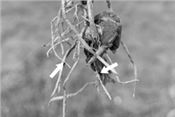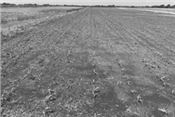|
Stand Loss Due To Seedling Disease
DR. KAITLYN BISSONNETTE
COLUMBIA, MO.
Conditions this spring have not only made planting a challenge, but have also resulted in challenges for seedling emergence. Cool, wet conditions slow germination and seedling emergence which increases the risk for early season disease development. Seedling diseases are a complex of pathogens that attack either the radicle or hypocotyl early in seedling development. Typically, as the plant ages, the risk of infection decreases. However, when development is slowed, the infection period is lengthened.
Seedling diseases can be hard to distinguish from other agronomic issues based on symptoms alone as aboveground symptoms include stunting, poor stand, wilting, uneven plant height, and chlorosis. When seedlings are carefully dug from the soil, brown or tan lesions may be observed on the root tissue; however, lesions may not appear in all cases and cannot be used for diagnosis. Due to the nature of the seedling disease complex, a post-mortem analysis of an affected seedling may result in the recovery of a whole host of pathogens. The kicker becomes the fact, that quite possibly, none of them may be the real reason why the seedling has died.
There are two main types of seedling diseases: those that are seedborne and those that are soilborne.
In corn, seedborne pathogens are commonly associated with ear rot pathogens. These include several members of the genus Fusarium such as F. verticilloides, F. proliferatum, F. subglutinans, and F. graminearum as well as the pathogens Penicillium, Aspergillus, and Trichoderma. In soybeans, the most common seedborne pathogens are Fusarium graminearum and pathogens that belong to the Phomopsis seed decay/Diaporthe complex.
There are also pathogens that are soilborne that live in the soil that can cause recurring problems in some fields. Corn pathogens include Pythium species, Rhizoctonia solani, and some member of the genus Fusarium. In soybeans, Pythium species, Phytophthora sojae, Rhizoctonia solani, and several Fusarium species are relatively common seedling pathogens. Fusarium virguliforme, the pathogen that causes soybean sudden death syndrome (SDS), also favors these cool, wet conditions, so it will be important to monitor those soybean fields that have already been planted as they approach the reproductive growth stages
Management of seedling diseases begins before seed is ever sown. Seed treatments are often beneficial as a barrier to these early season pathogens, but in years such as these, extended wet weather can result in reduced efficacy of seed treatment products due to high disease pressure. There are many seed treatment products commercially available for managing a wide variety of seedling pathogens for both corn and soybean. Information regarding soybean seed treatment efficacy can be found through the Crop Protection Network, in partnership with MU Extension.
It is important to note that some of the sickly-looking plants may be responding to nutrient deficiencies, cool temperatures, or both, and might not be the result of a disease. Knowing what to look for before making costly replant decisions is very important. ∆
DR, KAITLYN BISSONNETTE: Department of plant pathology, University of Missouri

Young corn seedling infected by seedling disease in wet soils due to spring rains in Central Missouri. Arrows point to areas
where pathogen has invaded and decayed young root tissue despite presence of seed treatment.

Poor stand and stunted plants have been commonplace throughout much of Missouri so far this season.
When scouting, these are the best areas to begin looking for evidence of early season seedling disease.
Courtesy of Bruna Just
|
|